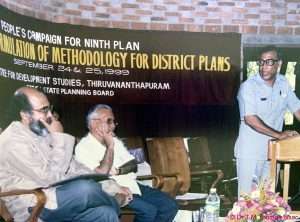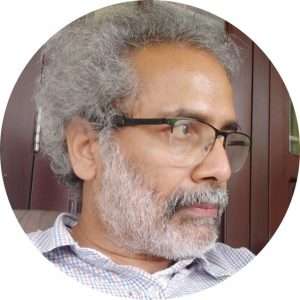TM Thomas Isaac, Richard W Franke (2021)
Left Word Publishers, New Delhi
Pages: 403
Price: INR 595
ISBN: 978-81-947287-2-6
As Kerala celebrates the 25th anniversary of its unique experiment with decentralised planning, it would be appropriate to remember that democratic decentralisation has become the principal point in debates on development strategies in the developing world, as it signifies greater access to power and resources by the people. Among the different pathways to this objective, greater devolution of authority and resources to the lower strata of government is viewed as a prudent option. However, this is a tricky proposition as leadership – political as well as bureaucratic – at upper hierarchical levels will not easily part with the power and privileges vested with them. It is quite unlikely that power will devolve on its own, unless and until mandated by law. Getting the ideals of democratic decentralisation translated into a pragmatic schema calls for a stormy political process, along with fundamental policy changes and a great deal of re-engineering of governance systems. Ensuring people’s real participation warrants such fundamental changes in polity as well as governance.
The book, authored by Dr Thomas Isaac, one of the chief architects of the people’s plan campaign and former Finance Minister of Kerala, and Dr Richard W Franke, Professor Emeritus of Anthropology at Montclair State University, Montclair, New Jersey, USA – who had followed the campaign in great detail since its inception – elaborately portrays the rationale of this initiative, how it could be substantiated ideologically and how it could be described as a political intervention for empowerment of the people. The two observe that the political strategy of decentralisation would mean creating a substratum for forging and nurturing mass initiatives of development and then carrying out the broadest possible spectrum of development experiments with people at the centre.
In fact, only a few states have translated the spirit of democratic decentralisation as envisaged in the 73rd and 74th Amendments of the Constitution in 1992 into concrete action points. Kerala, on the other hand had found this as an opportunity to transform and strengthen the local governments radically. This was marked by several bold steps to devolve financial and administrative powers and transfer all the important line departments operating at the grassroots level to the local governments. Further, in order to streamline people’s participation in the planning process, Kerala declared the Ninth Five-Year Plan which started in 1996 to be a people’s plan, implying that the plan would be drawn up by the people themselves, duly facilitated by political leadership of the local bodies, people’s representatives and volunteering experts. Local development plans would be formulated based on the needs and aspirations of the people as expressed in village councils or grama sabhas which would be projectized based on a few broad guidelines laid out by the government. This massive intervention was conceived as a campaign involving lakhs of people, through specialised democratic institutions and fora. This experiment did not have any precedent and it was huge.
People’s participation as a political strategy
The book speaks about the possibilities of such initiatives and provides a real time account of how such an experiment got implemented in Kerala State. In other words, people’s participation as a political strategy for inclusive development was an experiment in the unique socio-political milieu of Kerala, which had entailed several preconditions thanks to the legacy of public action and redistributive social development. With meticulous description and analysis of the course of evolution and roll out of this massive programme, the book is an invaluable contribution to development studies and all related disciplines in multiple ways. The book has been presented methodically in the order in which the various phases of the programmes progressed during the campaign, which are corroborated with the ideological, political and administrative logic behind each.
The first chapter illustrates the political and socio-economic changes that had taken place in a village – namely Panjal in central Kerala – since the early decades of the twentieth century as a microcosm of the saga of evolution of Kerala as a state, through different phases. These evolutionary changes were catalysed by various social reform movements and agrarian struggles that took place in the state from time to time. The authors succinctly describe that this bold and queer initiative of democratic decentralisation is grounded on the social transformation of Kerala driven by progressive forces.
The left-leaning governments that had ruled the state from time to time were responsible for triggering the strategy of equitable and redistributive growth. The book briefly examines how these social engagements by the left-oriented political contingent had redesigned the socio-political fabric of the state. Kerala’s renowned people’s science movement, massive literacy campaigns, voluntary agencies, trade unions, and other progressive organisations have contributed to the consolidation of these transformative experiences. The clamour for power to the people had been a political agenda espoused by the progressive segments of Kerala society.
Chapter 2 describes the history of local governments and decentralised planning in India, and the evolutionary course of the legislations on democratic decentralisation. The initiatives towards decentralisation in pre- and post-independent India, recommendations of various committees, constitutional amendments and the pioneering attempts at decentralisation by various state governments are also discussed in detail. This historical account reveals the magnitude of legislative efforts that were necessary to convert the ideals of democratic decentralisation into workable programmes over a period of time. Quite interestingly, the ideological underpinnings of the model of decentralised planning of development by local self-governments had long been a topic of debate in Kerala as it allegedly contravened the model of revolutionary change envisaged by left political organisations.
The third chapter deals with the political vision of decentralised planning and interprets the ideological nuances of this campaign, which is aptly described by the authors as a complex social engineering process. This discussion highlights the logic behind the bold decision by the Left Democratic Front (LDF) government to devolve as much as 30 per cent of the total plan funds to local bodies and equip local governments with the authority and capability to utilise the resources.
It should be understood that People’s Plan which paved the way for institutionalising the process of decentralised planning did not originate straight out of the blue. This was preceded by several local experiments and pilot programmes which could well be described as the prototypes of mass mobilisation witnessed in this programme. In fact, mobilising masses for a specific social aim requires conclusive narratives of the objectives put forth, definition of the organisation of the campaign, methodologies for garnering resources, ways to motivate people, and a well-crafted plan of action with possible outcomes and measures to ensure sustainability. Invariably, it also requires capacity building of available resources and the funds to organise and maintain the campaign.
Chapter 4 explains the experience of the mass literacy programme, one of the massive campaigns taken up in the state, wherein all of the above mentioned prerequisites were met almost perfectly. Similarly, the People’s Science Movement of Kerala had set off another participatory initiative of assessing local resources scientifically and drawing up local plans to use them judiciously for sustainable development of the productive sectors.
A chronological account of the major events of the campaign and the major activities in each phase is provided in chapters five to ten. The campaign got unfolded through distinct phases starting from grama sabhas. This was followed by consolidation of the requirements and wishes of the people in development seminars, formulation of task forces to prepare projects, consolidation of projects and making of local plans, collation and integration of local plans with plans at the block and district levels, appraisal of projects and plans by a group of experts at different levels, approval by the District Planning Committee, and finally, implementation. The new ways in which grama sabhas were conducted are explained in Chapter 5. These chapters provide us with a detailed account of the processes involved in each phase, methodological and other issues addressed by the campaign while defining the outlines of each stage, and how each of them was resolved.
 Dr. K. N. Shyamasundaran Nair, Dr M P Parameswaran and Dr T M Thomas Issac at an event on formulation of methodology for developing district plans during 1999
Dr. K. N. Shyamasundaran Nair, Dr M P Parameswaran and Dr T M Thomas Issac at an event on formulation of methodology for developing district plans during 1999
Learning from implementation
The results of this unique and massive intervention to decentralise governance at the end of the first year are examined critically in the eleventh chapter. The profile and approaches of local plans formulated by local self-government institutions in various development sectors during 1997-98 have been evaluated in order to find out whether this innovative exercise had been conceived by the stakeholder institutions as envisaged or not. In this context, the discrepancies in sectoral allocation, lack of efficiency of existing systems, weaknesses of the processes of planning, etc., are incisively examined. This is indeed an invaluable input for students of development studies as it gives insights on how a massive development intervention would impact various development sectors at the grassroots level, how the process had divergent implications, how it has deviated from the predetermined course and how it could be set right.
The complexities in the implementation of local level plans through the three-tiered local bodies and the innumerable administrative measures that were developed to implement them are detailed in Chapter 12. This is an incredible account of the reengineering of the business process that would be required to replace an archaic system with a new and vibrant system. I would say that the efforts to institutionalise the decentralised planning process by designing the financial and administrative procedures were unbelievably colossal. Moreover, ensuring that the new planning process conforms to the ideals of democratic decentralisation demanded a great deal of opinion making, consultations, and engagement with a wide spectrum of stakeholder communities.
There had been several international experiences that have similarities with the Kerala model of decentralised planning in several aspects. Chapter 14 attempts to do a comparative analysis of the features of Kerala’s people’s campaign with international experiences in democratic decentralisation and local level planning. The experiment of participatory budgeting in Porto Allegra Municipality in Brazil and similar attempts in various countries in Latin America have been closely examined to find similarities and dissimilarities. This is also critically compared with the participatory paradigms advocated by the World Bank funded projects in developing economies.
Sustaining the momentum
It should be noted that the people’s plan campaign had unleashed the tremendous potential of local people. This had resulted in a spontaneous outpouring of their ingenuity and imagination in problem solving. In fact, the most important part of this campaign is that local level planning which was considered to be a complicated and unilateral process could be implemented in much subtler ways by ensuring the most vital element: people’s participation. However, it must be mentioned that there were a few initial glitches which got resolved eventually.
The last chapter, aptly titled ‘Postscript’ attempts an overview of the 25 years of people’s plan movement by describing the cardinal features of the Kerala experiment. The authors convincingly conclude that the experiment had showcased the possibility of employing planning as an instrument of social mobilisation and how the conventional dictum on the sequence of democratic decentralisation was reversed.
However, how would you sustain the institutions and processes that evolved anew as the campaign got unfurled and advanced? This is a vital issue that will have to be addressed by any such movements that do not have a precedent. Even while timely improvement and transformations to integrate new challenges would be required, any attempt to reverse the process to earlier practices of centralisation would kill the spirit of this movement. The book tries to summarise the efforts towards institutionalisation of the campaign as a mandatory process that cannot be repealed fundamentally. This experiment in Kerala has produced a plethora of new experiences in local democracy, participative development, democratic decentralisation, and innovations in rural institutions.
Relevance to Extension Professionals
Why is this book important to extension professionals and scientists? Participatory development has been the main thrust of development debates since the weaknesses of the dominant paradigm had been revealed. We have also come across voluminous literature that describes the theory and praxis of participation in various socio-economic and political contexts and how it could be integrated into extension. However, participation in the entire course of formulation and implementation of development programmes had largely remained evasive, though all the development agencies, including the World Bank had advocated people’s participation as the underlying principle of every project implemented by them.
The Kerala experiment has not only addressed this issue but also contributed immensely to the domain of development studies by means of the rich lessons drawn from every stage, or its implementation and subsequent efforts to institutionalise this process. It has helped develop deeper insights on a wide range of topics such as modes of participation of people, resource allocation and deployment, development of social capital, innovations in administration, devising newer methods of grassroots level planning, institutional support to planning, public administration, public finance, gender mainstreaming, etc. In fact, all these lessons could be imbibed by the discipline of extension to enrich and develop its own content and methods. Democratic decentralisation is here to stay with more emphasis than ever before, as the rage of the current pandemic has underlined the importance of grassroots level planning, rural institutions, local capabilities and the need to mobilise local resources so as to sustain and go forward as a resilient community. And this book can certainly be resource material for developing a more stable and equitable society with people at the heart of it.
Dr Jiju P Alex
 Dr Jiju P Alex is Professor (Agricultural Extension), Kerala Agricultural University; and is currently serving as Member, State Planning Board, Government of Kerala (Email: jijupalex@gmail.com).
Dr Jiju P Alex is Professor (Agricultural Extension), Kerala Agricultural University; and is currently serving as Member, State Planning Board, Government of Kerala (Email: jijupalex@gmail.com).





Add Comment